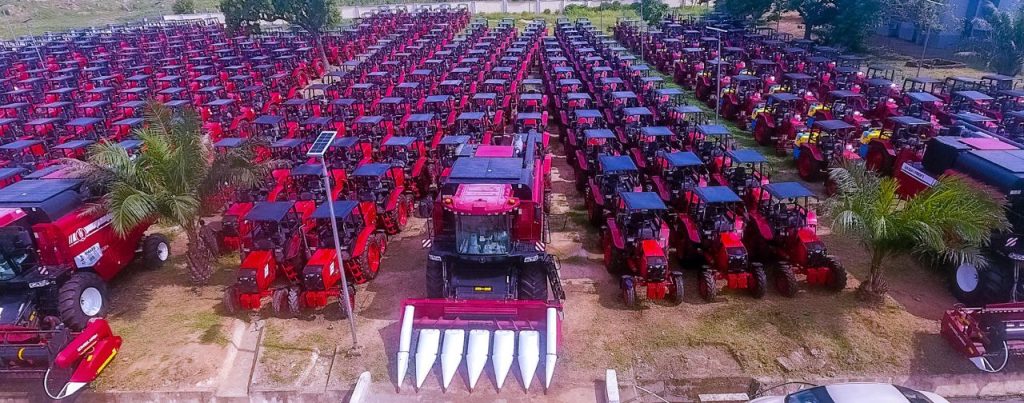Onome Amuge
President Bola Tinubu recently launched 2,000 tractors and thousands of associated farming implements under the Renewed Hope Agricultural Mechanisation Programme. Described by the government as the single largest mechanisation drive in the nation’s history, the initiative aims to boost food security and enhance national prosperity. Yet, amidst the ambitious pronouncements, agricultural experts and stakeholders are sounding notes of caution, drawing parallels with past government interventions that ultimately failed to deliver on their promise.
Speaking at the launch event in Abuja, President Tinubu underscored his administration’s commitment to fulfilling its electoral pledges, asserting a vision for a sustainable and technologically advanced agricultural future. “Today, we take a monumental leap forward with the introduction of the state-of-the-art tractors through our new agricultural mechanisation programme. We are very proud of what we are doing,” the President declared.
The initial phase of the programme encompasses over 2,000 advanced tractors, 50 industrial-grade land preparation bulldozers, 12 fully equipped mobile workshops, and more than 8,000 specialised farming implements. President Tinubu stressed that the strategic deployment of this equipment to mechanisation and service providers is not merely about increasing output but is also designed to create substantial job opportunities across the agricultural value chain.
“Our ambition extends beyond mere self-sufficiency. We envision Nigeria as a global agricultural powerhouse, supplying quality produce to international markets while ensuring every citizen has access to affordable nutrition,” he stated.
To ensure the long-term viability and technical proficiency required for this large-scale mechanisation, President Tinubu also announced a major partnership with Belarus, the tractors’ country of import. This collaboration aims to provide comprehensive training for Nigerian youth in critical areas such as machine operation, repairs, and mechanisation technology. Furthermore, the President issued a warning to all stakeholders entrusted with the new equipment, demanding maximum efficiency and accountability in its deployment and utilisation.
Corroborating the president’s optimism, Abubakar Kyari, the minister of agriculture and food security, hailed the programme as unprecedented in scale. “This is the single largest mechanisation drive ever undertaken in Nigeria,” Minister Kyari asserted.
The minister further elaborated that this programme is one of four major mechanisation schemes under the agenda, including the John Deere Tractorisation Programme, the Greener Hope Project, and the Green Imperative Programme. He commended the rapid implementation of the project, attributing it to a strategic technical partnership with AFTRADE DMCC, a global leader in agricultural machinery.
Detailing the rollout, Minister Kyari specified that the 2,000 high-quality tractors would be equipped with accessories such as trailers, ploughs, harrows, sprayers, and planters. The package, he noted, also includes 10 combined harvesters, 12 fully equipped mobile workshops, 50 bulldozers for land preparation, and over 9,000 complementary farming implements and spare parts.

“This is not just about distributing tractors. It is about transforming the entire narrative of Nigerian agriculture, from subsistence to scale, from effort to efficiency, from hand hoes to horsepower,” Kyari affirmed. The minister further detailed that to strengthen its effectiveness, the programme incorporates mandatory training for operators, GPS-based tracking for transparency, and financial support facilitated through development and non-interest banks.
Despite the fanfare and ambitious targets, agricultural analysts and stakeholders are approaching the initiative with cautious optimism, largely influenced by the historical landscape of well-intentioned but often poorly executed agricultural projects by previous Nigerian administrations.
Kabiru Ibrahim, President of the All Farmers Association of Nigeria (AFAN), acknowledged the government’s positive intent. He described the development as an act of good response to food security by the federal government. However, he pivoted to critical questions regarding the implementation strategy. “The period is also a good time to ask questions on the distribution and sales modalities because the 2,000 tractors are just a drop in an ocean,” Ibrahim noted.
For a nation of over 200 million people with vast arable land and a predominantly agrarian population, 2,000 tractors, when distributed across 36 states and the Federal Capital Territory, translate to roughly 74 tractors per state. This number, experts argue, is insufficient to make a significant dent in the country’s mechanisation deficit, which requires hundreds of thousands of tractors to truly transform the sector.
Adding another layer of concern, Solomon Oyeniran, an agro-food processing expert, lauded the launch as a good development, noting President Tinubu’s interest not just in food sufficiency but in having healthier foods. However, Oyeniran highlighted a pervasive and critical issue that could fundamentally undermine the programme’s success, which is the high spate of insecurity in major farming regions.
“The high spate of insecurity in some of the major farming places, including Benue, the food basket of the nation, is a major hindrance to the project as it may not allow the farmers to do what they are supposed to do. This is a very crucial issue,” Oyeniran stated.
Oyeniran also spoke on the minister’s sentiment regarding the scale of the intervention. “Looking at the population, he noted that the 2,000 tractors are still not enough considering that what the country consumes is large, and before the country can even think of exporting, it has to be self-sufficient. While commending the initiative, he expressed hope that the current administration would facilitate more such efforts.
Kayode Oyeleye, an agriculture business analyst, articulated perhaps the most pointed concerns, urging caution before celebrating the intervention. His primary apprehension stems from what he perceives as the absence of a transparent and detailed deployment strategy.
“Before we pat ourselves on the back, especially with regards to the 2,000 tractors, we should look at quite a number of things,” Oyeleye stated. He specifically questioned the distribution model: “I will be interested in the business model that is behind this idea of 2,000 tractors and out sharing them to the states.” He probed deeper, asking about the basis for sharing, the nature of Memoranda of Understanding (MoUs) with sub-national governments regarding utilisation, and whether these tractors would be paid for or granted.
Another concern raised by Oyeleye is the potential for political interference and misappropriation, a recurrent challenge that has plagued similar government initiatives in the past. He voiced strong apprehension that the valuable machinery might not reach its intended beneficiaries (the farmers). “This is a problem when [in] a politically charged environment, many of these tractors will eventually end up in the backyards of some senators, some ministers, or some politically exposed people, and may not eventually get to the farmers,” he warned.
Oyeleye argued that agricultural business and the deployment of farming equipment are responsibilities best managed at the local and state government levels, given their proximity to the grassroots farming communities. He contended that federal-level projects, if not properly structured, can often become financial drainpipes and mere populist ventures that fail to deliver tangible impact.
“I actually wonder how the tractors are intended to be used, monitored and maintained. Having seen this kind of script played out in the past, it is easy to predict where and how this one will end,” he stated further.
To counter this, Oyeleye advocated for a robust Public-Private Partnership (PPP) model for the initiative’s deployment. He proposed that while the federal government could facilitate the importation of the tractors, their actual deployment and management should be executed by states and local government councils in close collaboration with a diverse array of stakeholders. These would include farmers’ associations, tractor operators’ associations, financial institutions (banks), insurance providers, and relevant government officials. He also stressed the importance of involving established bodies like the Tractor Owners and Operators Association of Nigeria to ensure practical and effective implementation.
Nigeria’s agricultural sector, according to analysts, is historically reliant on rudimentary methods, and is in dire need of mechanisation to unlock its vast potential. The country’s arable land is considered largely underutilised, and productivity remains low due to manual labour and limited access to modern farming techniques.
Though many agree that the Renewed Hope Agricultural Mechanisation Programme certainly represents a significant capital injection aimed at addressing this fundamental gap, it is believed that the success of this ambitious programme hinges not merely on the acquisition of state-of-the-art machinery but on the transparent and efficient implementation of its distribution, utilisation, and maintenance.
Thus, analysts assert that learning from past failures means establishing clear and accessible modalities for farmers to acquire or lease these tractors, ensuring equitable access that transcends political affiliations, and setting up robust monitoring mechanisms to prevent diversion and ensure optimal use.
Furthermore, analysts pointed out that the persistent challenge of insecurity in Nigeria’s food-producing regions cannot be overstated. They contend that without a significant improvement in the safety of farmers and farmlands, even the most advanced machinery will remain underutilised or become vulnerable to theft and damage.









